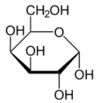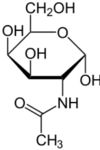Garman lab: Interconversion of lysosomal enzyme specificities
From Proteopedia
Contents |
How this page was created
The goal of this page is to provide three-dimensional and interactive figures to explore the structures determined for the 2010 paper "Interconversion of the Specificities of Human Lysosomal Enzymes Associated with Fabry and Schindler Diseases" by Ivan B. Tomasic, Matthew C. Metcalf, Abigail I. Guce, Nathaniel E. Clark and Scott C. Garman[1]. The starting point are the figures found in this paper. Biochemistry students at Westfield State University recreated these figures in jmol, and revised them after getting feedback from the authors. A special thank you goes to Susan Al Mahrwuth, Samuel J. Butler, Susy Civil, Westin G. Cohen, Allison F. DeVivo, Tyler S. Fassett, Courtney M. Fisher, Kimberly Garcia, Stephanie L. Hardy, Maureen W. Kamau, Sienna R. Kardel, Allyson L. Kress, Julia M. Lahaie, Stephen A. Malerba, Brittany E. Ricci, Kimberly Rosario, Yelena Vynar, and Deanna N. Womack for creating the initial figures and captions. If you are interested to learn how these figures were made, take a look at the discussion page (2nd tab above).
Lysosomal storage disease
Lysosomal storage disorders are inherited metabolic diseases characterized by an accumulation of undigested various toxic materials. There are nearly 50 diseases and the two examples shown here are Fabry and Schindler disease. Fabry disease, which occurs between early childhood and adolescence, is characterized by the lack of the enzyme alpha galactosidase (GAL). Schindler disease can occur in infancy or in adulthood and is characterized by the lack on the enzyme alpha N-acetylgalactosaminidase (NAGAL). There are currently no cures for lysosomal storage disorders however enzyme replacement therapy is a treatment option. The basic principle of enzyme replacement therapy is to overexpress the defective or missing enzyme of interest heterologously in a cell line and to isolate and purify it from the culture. In enzyme replacement therapy, patients are injected with the enzymes that they lack in the hopes of restoring the enzymatic activity in their cells.
Immune Response
Individuals suffering from Fabry disease cannot produce the GAL protein that is necessary for breaking glycosidic bonds of galactose. The usual treatment for this is giving the patient doses of the protein, but this poses a problem. Since the body does not produce the protein, an immune response ranging from severe anaphylaxis to mild discomfort can occur when the patient is given the protein. The body does however produce NAGAL, a protein with a similar active site and function as GAL. Making a new protein closely related to NAGAL with an active site that matches that of GAL allows doctors to administer a protein that serves the function of GAL but has the antigenicity of NAGAL, which means the body will recognize the protein and not elicit an immune response.
Enzymatic activity
The enzymes GAL and NAGAL have almost identical active sites, with all residues conserved except for two. Where NAGAL has an alanine and a serine, GAL has a glutamate and leucine. The two enzymes have the same folds and both function to cleave glycosydic bonds, but with different substrate specificities. The differences in substrate specificity occur because NAGAL has the smaller two residues, resulting in a larger binding pocket allows it to bind to N-acetyl galactosamine, which is larger than galactose.
Galactose vs. N-acetyl-galactosamine
The initial rotating molecule in the 3D browser (scroll down if you don't see it) shows the sugar . If you turn off the spinning (click on the +/- control below the spinning molecule) and hover over the atoms, you can learn which colors represent carbon, nitrogen and oxygen (it will display a string like "[A2G]2000:B.C1 #6538", where the letter after the period gives the element symbol, in this case C for carbon).
Structures shown on this page
3H54: the enyme NAGAL in complex with the sugar N-acetyl galactosamine
3HG5: the enyme GAL in complex with the sugar galactose
3LX9: the enyme GAL(SA) in complex with the sugar N-acetyl galactosamine
3LXA: the enyme GAL(SA) in complex with the sugar galactose
Image:Interconversion_model.pdb: Superposition of 3H54 and 3HG5 to make hypothetical model of binding the "wrong" sugar (bonus figure Y).
Overview of the research, and recreated figures
| |||||||||||
Relevant links
Structures on proteopedia associated with the Garman lab
References
- ↑ 1.0 1.1 1.2 Tomasic IB, Metcalf MC, Guce AI, Clark NE, Garman SC. Interconversion of the specificities of human lysosomal enzymes associated with Fabry and Schindler diseases. J Biol Chem. 2010 Jul 9;285(28):21560-6. Epub 2010 May 5. PMID:20444686 doi:10.1074/jbc.M110.118588


